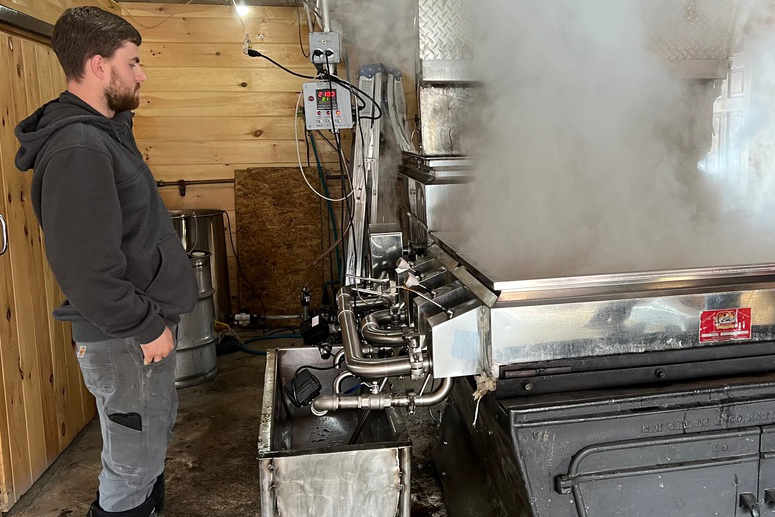
Holly and Steve Hardwick of Eagle Lake can’t believe they’re tapping maple trees in March and not struggling through snow.
In the past, they’ve snowshoed on about four feet of snow to tap their trees.
But this year, unseasonable warmth, rain and snowmelt started the process a month early. While that could be a blessing up north, some southern Maine syrup producers say their season is over.
For all of them, Maine’s warming climate points toward unpredictable seasons that could mean less product to sell.
Maple is big business in Maine, which is the third largest syrup producer in the nation. The state produces 575,000 gallons of maple syrup in an average season, which contributes more than $55 million to the state’s economy, according to the Maine Maple Producers Association.
But production varies from year to year. Maine produced 514,000 gallons in 2021, which skyrocketed to 634,000 in 2022, according to the United States Department of Agriculture. Last year, an early warmup cut the season short and production plummeted to 470,000 gallons.

The Hardwicks, who own Northwoods Nectar, felt that pinch.
“Last year the sap didn’t really run until the second week of April, and then it warmed up too quickly. We only made half the usual amount of syrup,” Hardwick said. They typically make 750 gallons a year off their 100 acres.
She hopes they’re far enough north that the warmup will hold off and give them a longer season this year. They’re on their fourth batch of syrup, which usually doesn’t happen until April, and she expects to boil sap every day for the next month.
Syrup producers Lori and Barry Dana are about on schedule with their sap boiling. But as sweet-smelling steam rose off the wood-fired evaporator in their Solon garage, they wondered if they would ever see a typical season again, given increasing warming winters and extreme weather events in the state.
This season instead of snowshoeing to collect the sap from around 200 tapped trees, the couple was able to walk on solid ground. Any snow that fell over central Maine this winter has long melted away, leaving the ground bare.
“When you used to listen to the old-timers who made syrup they would tell you these tales of when their knees hurt, they knew it was time to tap trees,” Barry Dana said. “That told them the temperatures were going to be 20-degrees or less at night and between 45- and 50-degrees during the day.”
Those temperatures, according to Barry Dana, have long been considered optimal for the sap in maple trees to start running. Those were also conditions virtually guaranteed in this part of Maine in February and March.
Now the temperatures in the winter are fluctuating so much that they are not sure what the conditions will be in advance, Lori Dana said. This means instead of a solid four or five weeks of sap running every day, it’s more hit and miss.
“I look out the window and see if the puddles are frozen on the driveway,” she said. “These days what the driveway looks like is our gauge on if the sap is running and we really need to stay on top of it.”

Last year the Danas started collecting sap several weeks later than previous years. This year they started a week earlier than normal.
Several days ago, according to the weather reports, the temperatures were not going to drop down far enough at night to promote a sap run. But when the Danas checked their collection barrels, they found them full of liquid — despite the warmer temperatures.
“What we are seeing around the state are a series of micro seasons,” said Lyle Merrifield, president of the Maine Maple Producers Association. “Instead of one season, depending where you are in the state, things are more sporadic.”
Those who think their sap is done should wait a bit, said Jason Lilley, UMaine Cooperative Extension sustainable agriculture and maple industry educator. He pointed out a cold weekend forecast that could restart sap flow.
That’s what the Danas are counting on after getting a mere five gallons of sap on Friday.
“It used to be our last tap was always on April 29,” Lori Dana said. “Last year we stopped a week earlier and we have no idea how long this season will run.”
The season may change timewise, but as long as the freeze-and-thaw balance remains the same the sap will flow, Lilley said.
“The projections are that the seasons will continue to get earlier and just be more erratic,” he said.
Trees don’t care what the calendar date is, but the maple season could eventually happen in January or even December, he said.
Bart Bradbury of Bridgewater is eyeing the unusual season with some caution.
“It’s not too often that you’re standing here on the first of March and looking through the woods with very little snow,” said Bradbury, whose family owns Bradbury Maple Farm. “It’s very unusual for us. It’s similar to the southern part of the state.”
Bradbury’s operation taps 4,400 trees and produces about 1,500 gallons of syrup a year, he said. If conditions stay as they are until the trees bud, that’s good.
Merrifield said changes to Maine’s maple syrup industry due to climate change are here to stay, but he is confident the producers — and the trees — can adapt.
“We may have to come up with different ways to get sap from the trees but I think that sap will always be running,” he said. “I am always surprised at what the trees can do.”
People can adapt too. There is no snow in Aroostook this year for the Hardwicks to offer maple taffy, but they have a snow cone machine. The latest flavor — maple.







